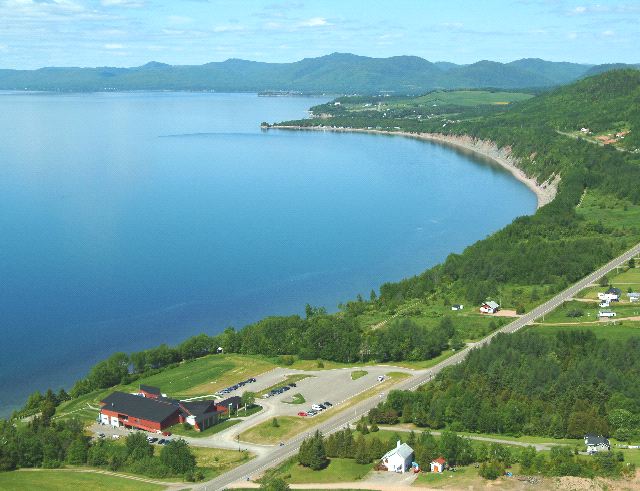Home

 (52 kb) Over time, the name changed to Miguasha, but the place is still just as red. In the evening, when the setting sun bathes the cliffs in glowing light, the rocks turn beautiful shades of crimson.
(52 kb) Over time, the name changed to Miguasha, but the place is still just as red. In the evening, when the setting sun bathes the cliffs in glowing light, the rocks turn beautiful shades of crimson.Located at the western end of the Baie-des-Chaleurs along the northern shore of the Ristigouche River, Miguasha owes its red colouring to the rocks of the Bonaventure rock formation. But the area is most famous for another series of rocks – the Escuminac Formation – which lies under the Bonaventure Formation at beach level. For more than 125 years, the Escuminac Formation has garnered worldwide acclaim among paleontologists. Thousands of beautifully preserved fossils have been extracted from the Escuminac cliffs, mainly of fish that lived 380 million years ago during the Devonian Period.
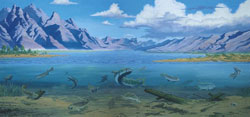
 (40 kb)In recognition of its paleontological significance, UNESCO declared Miguasha a World Heritage Site in 1999. The Parc national de Miguasha, established in 1985, ensures the protection of this fossil-rich site and maintains an impressive collection of specimens in its Natural History Museum, founded in 1978. The park and museum offer visitors an exceptional opportunity to learn about paleontology and discover one of the most important moments in the evolution of life on Earth: the emergence of the first vertebrates to venture on land in a world that had been dominated until then by water-dwelling creatures.
(40 kb)In recognition of its paleontological significance, UNESCO declared Miguasha a World Heritage Site in 1999. The Parc national de Miguasha, established in 1985, ensures the protection of this fossil-rich site and maintains an impressive collection of specimens in its Natural History Museum, founded in 1978. The park and museum offer visitors an exceptional opportunity to learn about paleontology and discover one of the most important moments in the evolution of life on Earth: the emergence of the first vertebrates to venture on land in a world that had been dominated until then by water-dwelling creatures.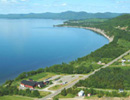
 (60 kb)Miguasha is a bit like a photo that shows us what it was like in this corner of the planet very long ago. The photo may be a bit faded, but it still reveals an incredible amount of detail to paleontologists who are willing to study it carefully and with great patience.
(60 kb)Miguasha is a bit like a photo that shows us what it was like in this corner of the planet very long ago. The photo may be a bit faded, but it still reveals an incredible amount of detail to paleontologists who are willing to study it carefully and with great patience.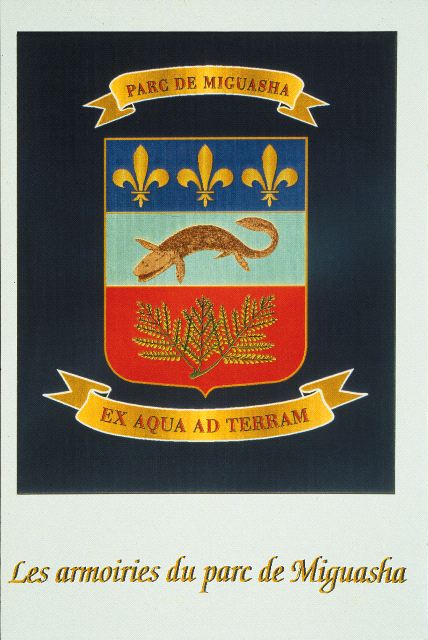
Title: The Miguasha coat of arms
Author: Designed by Marius Arsenault
Sources: Parc national de Miguasha
Year: 1996
Description:
Blazon tierced per fesse with, in chief, three fleurs-de-lys against an azure background bringing to mind the presence of the park in Quebec territory.
In centre fesse, the Elpistostege watsoni, a fish of the colour of Miguasha fossils in transition towards becoming a tetrapod, against the turquoise background of an equatorial estuary.
On the champagne, red base and a fern with fronds and fan-shaped leaflets, in chief, reminiscent of the red soil of Miguasha and the Archaeopteris halliana, a primitive tree of the Devonian.
The motto “Ex aqua ad terram” means ‘From water to land”. Descriptive text by Marius Arsenault and Philippe Janvier.
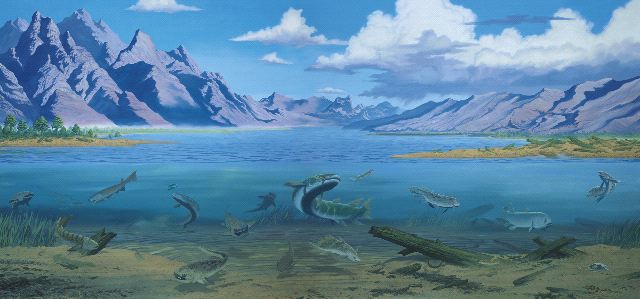
Title: The Miguasha paleoestuary
Author: Illustration by François Miville-Deschênes
Sources: Parc national de Miguasha
Year: 2003
Description:
A fresco of the ancient Miguasha estuary with the peaks of the young Appalachian mountain range in the background. The fish fauna were diversified, but it was Eusthenopteron foordi that dominated this watery world. Vegetation was concentrated along the shore, dense and tall enough in places to make forests.



